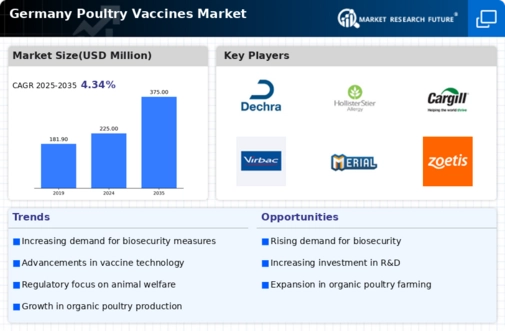Emerging Avian Diseases
The emergence of new avian diseases poses a significant challenge to poultry producers in Germany, driving the poultry vaccines market. Diseases such as avian influenza and Newcastle disease have been reported, leading to substantial economic losses in the poultry sector. In response, the German government has implemented stringent measures to control these outbreaks, including vaccination campaigns. The poultry vaccines market is expected to grow as producers seek to protect their flocks from these emerging threats. Vaccination not only helps in disease prevention but also plays a crucial role in maintaining the overall health of poultry populations. As awareness of these diseases increases, the demand for effective vaccines is likely to rise, prompting further investment in research and development within the poultry vaccines market.
Consumer Awareness and Education
Growing consumer awareness regarding animal health and food safety is driving the poultry vaccines market in Germany. As consumers become more informed about the importance of vaccination in preventing diseases, they are increasingly demanding assurance that poultry products are sourced from healthy flocks. This shift in consumer behavior is prompting poultry producers to prioritize vaccination programs to meet market expectations. In 2025, surveys indicate that over 70% of consumers are willing to pay a premium for poultry products that guarantee health and safety standards. Consequently, the poultry vaccines market is likely to expand as producers respond to consumer demands by implementing comprehensive vaccination strategies, thereby ensuring the health of their poultry and the safety of their products.
Government Initiatives and Support
Government initiatives aimed at enhancing animal health and welfare are significantly influencing the poultry vaccines market in Germany. The German government has introduced various programs to support poultry farmers in adopting vaccination practices. Financial incentives and subsidies for vaccine purchases are being offered, which encourages farmers to invest in vaccination programs. In 2025, it is estimated that government funding for animal health initiatives will exceed €50 million, reflecting a commitment to improving poultry health standards. These initiatives not only promote the use of vaccines but also enhance biosecurity measures across the industry. As a result, the poultry vaccines market is likely to experience growth driven by increased government support and funding, fostering a healthier poultry sector.
Rising Demand for Poultry Products
The increasing consumption of poultry products in Germany is a primary driver for the poultry vaccines market. As consumers become more health-conscious, the demand for safe and disease-free poultry has surged. In 2025, the poultry meat consumption in Germany is projected to reach approximately 1.5 million tons, indicating a growth of around 3% from previous years. This heightened demand necessitates the implementation of effective vaccination programs to ensure the health of poultry flocks, thereby reducing the risk of disease outbreaks. Consequently, poultry producers are investing in vaccines to maintain flock health and meet consumer expectations. The poultry vaccines market is likely to expand as producers seek to enhance biosecurity and ensure the quality of their products, aligning with consumer preferences for safe and healthy food options.
Technological Innovations in Vaccine Delivery
Technological innovations in vaccine delivery systems are transforming the poultry vaccines market in Germany. Advances in vaccine formulations and delivery methods, such as needle-free vaccination and oral vaccines, are enhancing the efficiency and effectiveness of vaccination programs. These innovations reduce stress on poultry during vaccination, leading to better overall health outcomes. In 2025, it is projected that the adoption of these advanced delivery systems will increase by approximately 20%, as producers seek to improve flock health and streamline vaccination processes. The poultry vaccines market is likely to benefit from these technological advancements, as they enable more effective disease control and contribute to the overall sustainability of poultry production in Germany.






















Leave a Comment